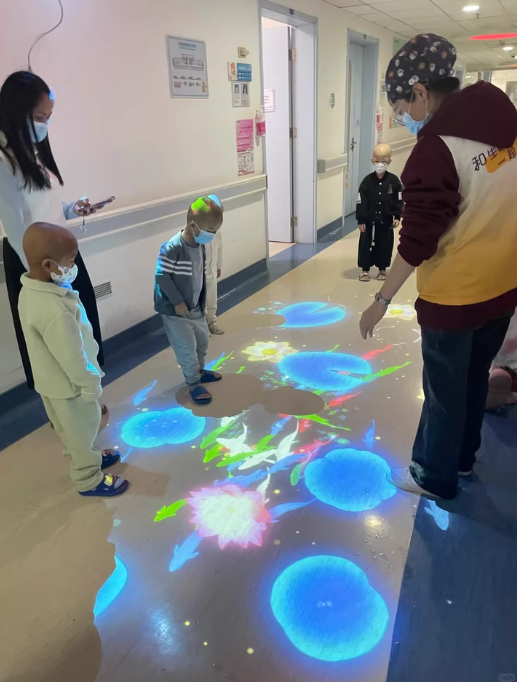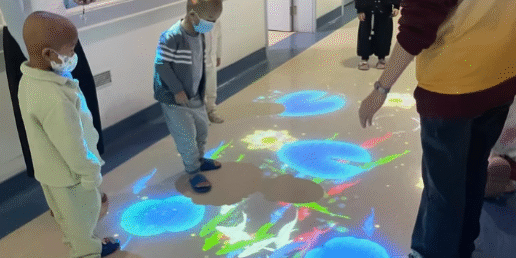Introduction: A Smarter Path to Recovery
As rehabilitation methods evolve, healthcare providers and rehabilitation centers are exploring technologies that offer greater safety, efficiency, and personalization. One standout innovation is LiDAR interactive projection training, which combines real-time motion capture with immersive projection to deliver a highly engaging and intelligent recovery experience.
How does it compare with traditional rehabilitation practices? In this article, we provide a comprehensive comparison to highlight why LiDAR-based systems are becoming the preferred choice for many modern rehabilitation facilities.

Key Advantages of LiDAR Interactive Projection Training
Contactless Motion Tracking
Traditional rehabilitation often requires rehabilitation patients to wear sensors or rely on therapists for direct physical guidance. This not only creates inconvenience but also increases the risk of cross-infection, especially in clinical or high-traffic environments.
LiDAR-based systems offer completely contactless tracking, making them ideal for use in pandemic-conscious settings and with sensitive populations such as the elderly or immunocompromised individuals.
Real-Time Interaction and Feedback
Traditional feedback relies heavily on the therapist’s presence and observation. In contrast, interactive projection training systems capture every movement in real time, providing instant feedback via visual and auditory cues.
If a patient performs an action incorrectly, the system can immediately alert them, improving both safety and effectiveness during independent sessions.
Enhanced Engagement and Motivation
Repetitive exercises in conventional therapy can feel monotonous, leading to low motivation among rehabilitation patients. LiDAR interactive training addresses this with:
- Dynamic visuals
- Gamified experiences
- Audio and visual stimulation
These elements help boost participation and reduce resistance to therapy, especially among children and elderly patients.
Data-Driven Assessment and Progress Tracking
Unlike traditional rehabilitation, where assessments are often subjective and manual, LiDAR projection systems automatically record every training session and generate detailed analytics. Reports may include:
- Movement accuracy
- Completion rates
- Session duration
- Improvement over time
This data allows for quantifiable and transparent evaluation, empowering therapists and patients to track progress more scientifically.
Scalable and Personalized Training
Conventional methods are often limited by human resources and are difficult to scale. LiDAR systems can:
- Track multiple users simultaneously
- Deliver individualized training programs based on user profiles
- Adjust difficulty dynamically in real time
This makes the system suitable for hospitals, community centers, and care facilities where patient volume is high.
Reduced Therapist Workload
Because the system automates monitoring and feedback, therapists can supervise multiple patients at once, focusing their attention where it’s needed most—such as with high-risk or complex cases. This optimizes professional resource allocation.
Comparative Summary: LiDAR vs. Traditional Rehabilitation
| Feature | LiDAR Interactive Projection Training | Traditional Rehabilitation |
|---|---|---|
| Interactivity | Real-time projection, visual/audio feedback, immersive | Therapist-led, limited interaction |
| Data Tracking | Automatic, detailed, and objective | Manual, subjective, and limited |
| Engagement | High—uses gamification, visual and auditory stimulation | Low—often repetitive and monotonous |
| Contactless Operation | Yes—no need for wearables or physical contact | No—often requires direct touch or equipment use |
| Personalization | AI-based, customizable training plans | Therapist-led customization, limited standardization |
| Resource Efficiency | High—supports group training, reduces labor | Low—requires one-on-one supervision |
| Safety | High—reduces infection risk, non-invasive | Moderate—contact-based, limited infection control |
Suitable Use Cases for LiDAR Projection Training
LiDAR-based interactive rehabilitation is ideal for:
- Large-scale public health facilities
- Community-based rehabilitation programs
- Pediatric or elderly rehabilitation
- Patients with limited mobility
- Smart fitness parks and wellness centers
Traditional rehabilitation still plays a vital role for complex cases requiring hands-on intervention, such as post-operative therapy or neurological rehabilitation. However, LiDAR projection training acts as a powerful complementary method that expands access, improves engagement, and enhances efficiency.
Conclusion: An Intelligent Upgrade to Traditional Therapy
LiDAR interactive projection training is not about replacing therapists—it’s about enhancing rehabilitation through smarter, safer, and more engaging technology. With features like contactless sensing, instant feedback, gamification, and real-time analytics, these systems represent a major step forward in modern physical therapy.
As healthcare environments face increasing demand for scalable and personalized rehabilitation solutions, LiDAR technology offers a future-ready answer.
CPJROBOT is a leading manufacturer specializing in POE interactive LiDAR and industrial radar technology. We provide customizable radar-based solutions for rehabilitation, motion tracking, and intelligent projection systems.
Looking to build a smarter rehabilitation environment?
Contact CPJROBOT today to explore how our LiDAR solutions can support your innovation in physical therapy and patient recovery.







